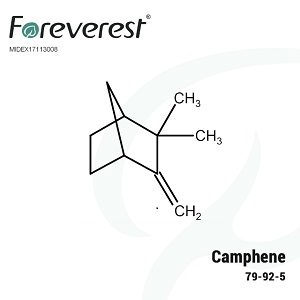Camphene 97%, 96%
Camphene, a colourless and crystalline solid, is found in minute quantities in Turpentine. Its odour is similar to Camphor, and it is nearly insoluble in water, but well soluble in common organic solvents. It is a minor constituent of many essential oils such as Turpentine, Cypress oil, Camphor oil, Citronella oil, Neroli, Ginger oil, and Valerian.
Camphene is used chiefly as materials for Synthetic Borneol, Sandalwood fragrance, Synthetic camphor, Synthetic perfumes, IBOA, Toxaphene perfume, medicines and other synthetic organic chemicals. It is also used as a food additive for flavouring, and as a flavouring agent in soap and deodorant, and as a raw material for pesticides.
Substance Identification
| Synonyms | 2,2-Dimethyl-3-methylenenorbornane, | 3,3-Dimethyl-2-methylenenorcamphene |
| CAS | 565-00-4, 79-92-5 |
| EINECS | 201-234-8 |
| FEMA | 2229 |
| HS.CODE | 290219 |
| Molecular Formula | C10H16 |
| Moleclar Weight | 136.24 |
Toxicological Information
| LD50 oral, rat | 5g/kg min |
| LD50 dermal, rabbit | 2.5g/kg min |
Application & Uses
- Chiefly used as materials for Synthetic Borneol, Sandalwood fragrance, and other synthetic organic chemicals.
- Used as a food additive for flavouring.
- Used as a flavouring agent in soap and deodorant.
- Used as pesticide raw materials.
Sales Specification
| ITEM | VALUE | TEST METHOD & UNIT |
|---|---|---|
| Appearance | Feather like white crystal | |
| Relative Density | 0.842 | @d20/4 |
| Solubility | Practically insoluble in water | |
| Purity | 97 min | @GC, % |
| Pure Camphene | 82 min | % |
| ITEM | VALUE | TEST METHOD & UNIT |
|---|---|---|
| Appearance | Feather like white crystal | |
| Relative Density | 0.842 | @d20/4 |
| Solubility | Practically insoluble in water | |
| Purity | 96 min | @GC, % |
| Pure Camphene | 78 min | % |
Package
- Galvanized Iron Drum (new), 170kg net each, 80 drums (13.6 mt) per 20’FCL.
- Goods can also be packed in 1000L IBCs or ISO Tanks according to customers' requirements.
GHS Hazard Statements
| H-Code | H228/319/411 |
| P-Code | P210/240/241/264/273/280 |
| Response | P305+P351+P338 P337+P313 P370+P378 P391 |
| Storage | no data available |
| Disposal | P501 |
Storage
- Environmental & Temperature Control:
- Store in a cool, dry, well-ventilated area, and protect from light.
- Avoid high temperatures to maintain product stability and prevent decomposition or volatilisation.
- Keep in a cool, well-ventilated place.
- Container Management & Prevention:
- Ensure containers are tightly closed to prevent volatilisation and external contamination, and are clearly labelled.
- Ground all equipment containing the material to prevent static build-up.
- Hazard Isolation:
- Keep storage areas away from heat, sparks, open flames, and all sources of ignition.
- This combustible liquid should be stored in a separate safety storage cabinet or room.
- Keep away from incompatible materials to prevent hazardous reactions.
- Safe Handling & Inspection:
- Handle carefully, and stack stably.
- After prolonged storage, always check quality before use.
- Compliance & Emergency Preparedness:
- Strictly comply with all safety regulations, particularly those pertaining to combustible liquid storage.
- Ensure emergency plans are in place for unforeseen circumstances.
Relation Products
Relation Articles
Remark
Start Purchasing
-
Minimum Order Quantity
Quote required -
Lead Time
Quote required -
Available Incoterms
Quote required -
Regional Availability
Quote required
